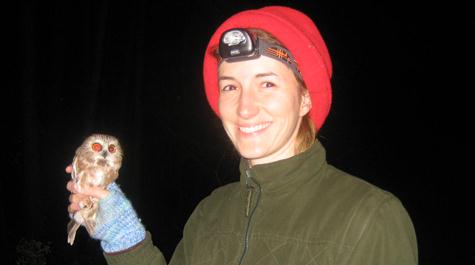A grants administrator gets a night out in the field
Erica Lawler says that they look like little ice cream cones, but Lawler is in fact referencing the upside down northern saw-whet owl that she was able observe after an opportunity she took to spend a night out in the field with them.
Libby Mojica, a wildlife biologist at the Center for Conservation Biology, invited Lawler on the investigative excursion after Lawler expressed an interest in the fluffy pint-sized animals. Lawler says being close to the active research was fantastic new and different experience. Her typical duties at William & Mary are on the paperwork side as an administrator in the Office of Sponsored Programs processing grants for the CCB and other researchers.
Lawler and her colleagues are vital parts of the research aspect of William & Mary, but she typically can only ever get as involved in actual research as reading grant applications and reports. This time however, she witnessed all of the processes that go into data collection of the northern saw-whet, and then was even allowed to hold one for a few minutes.
“The Center for Conservation Biology has a lot of data depicting over time when there is a boom population, or when the migration gets thrown off course,” says Lawler. Researchers net the small owls for banding, measure and weigh them to create a profile of their presence in Virginia. Lawler notes that this year changes arose after the late October hurricane that forced the saw-whets further inland.
On a night in mid November, Lawler accompanied Mojica and three-year veteran CCB technician Zak Poulton to some off-the-beaten-path trails to work with these owls. While it may have been Lawler’s first time out in the woods with the owls, the CCB has been working with the species for almost twenty years now.
“The project started in 1994 when the Center for Conservation Biology saw an information gap in the life cycle of these migratory owls,” says project leader Fletcher Smith of the CCB. Smith explains that scientists had no knowledge of a significant presence of the saw-whet any more southern than Cape May, New Jersey; so when 50 were accounted for in the lower Delmarva Peninsula in just the first year, that seemed like the beginnings of something really amazing.
Smith says that within one year of the project’s birth, CCB researchers had banded over a thousand owls, more than any other banding station in the mid-Atlantic. The ornithologists seek to determine how many owls are coming through, and where they’re going.
Researchers use mist nets to capture these owls, whose only defense mechanism is to shut their eyes very tightly and hold perfectly still. Lawler says this behavior is exactly why people think saw-whet owls are so calm and gentle.
“Each net has four little pockets so that when the owls fly into the net they kind of bounce down and get caught up in the pockets to hold them in one place,” said Lawler. After being caught and removed from the net, the first step of the process is banding owls that haven’t been caught before and recording the data on the already-banded owls.
The next step was to weigh the owls. A drinking glass is attached to a portable scale, tared to zero.
“Head first the little owls got dropped in, and you could see them looking at you through the glass!” says Lawler. The inverted owls in the drinking glass made Lawler think about ice cream cones. Her one-word description of the saw-whet: “adorable.”
“The part I thought was the most interesting was when they used the black light,” Lawler explained. This specialized technique is used in determining the ages of these owls. A black light wand is waved over their human hand-sized bodies, and the newest feathers glow brightly. Feathers from years before that haven’t been molted out yet do not show up so vibrantly under the black light, allowing researchers to determine how old the owl is based on how many times the animal has molted.
The owls then are treated to a period of readjustment in total darkness, a time when Lawler herself was allowed to hold them before they fluttered off into the night.
“It’s really neat for me because so much of the time I’m just on the budgeting and agreement side of the research, and you can feel very removed from what’s actually happening,” says Lawler. “It does give me some perspective."
 Skip to main content
Skip to main content

